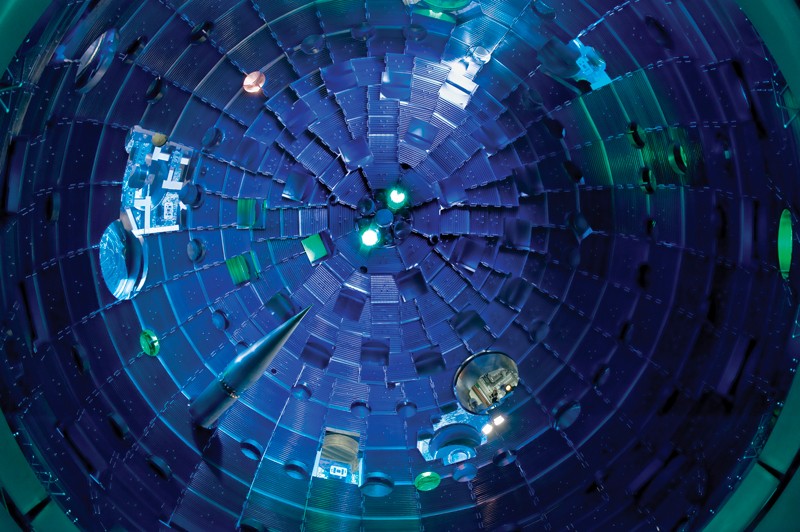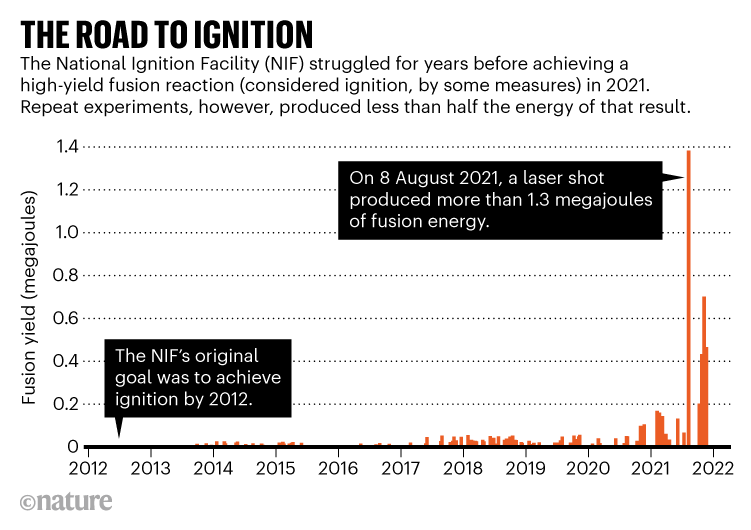US scientists evaluate their options after failing to replicate record-setting experiment from 2021.

Inside the target chamber at the US National Ignition Facility, scientists focus 192 laser beams on a gold capsule containing deuterium and tritium, in an attempt to achieve nuclear fusion.Credit: Lawrence Livermore National Laboratory/Science Photo Library
Nearly one year ago, scientists at the world’s largest laser-fusion facility announced a landmark achievement: it had shattered all records and produced, if only for a fraction of a second, an energetic fusion reaction of the kind that powers stars and thermonuclear weapons. Yet efforts to replicate that experiment have fallen short. Nature has learnt that, earlier this year, researchers at the California facility changed direction, moving to rethink their experimental design.
The turn of events has renewed debate about the future of the National Ignition Facility (NIF), a US$3.5-billion device that is housed at Lawrence Livermore National Laboratory and overseen by the National Nuclear Security Administration (NNSA), a branch of the US Department of Energy that manages nuclear weapons. The NIF's primary mission is to create high-yield fusion reactions, and to inform maintenance of the US weapons stockpile.
By some measures, the record-setting laser shot on 8 August 2021 proved that the facility, which has cost much more and yielded much less than originally promised, has at last accomplished its main mission. Repeat attempts, however, yielded at best 50% of the energy produced late last year. Researchers didn't expect smooth sailing while trying to replicate the experiment, because the massive device is now operating at the cusp of fusion ‘ignition’, where tiny, inadvertent differences from one experiment to another can have huge impacts on output. Nonetheless, for many, the failure to reproduce last August's experiment underscores researchers' inability to understand, engineer and predict experiments at these energies with precision.

Omar Hurricane, chief scientist for Livermore's inertial-confinement fusion programme, has advocated pressing forwards with the existing experimental design to probe this energy regime, rather than stepping back to regroup. “The fact that we have done it is kind of existence proof that we can do it,” he says. “Our issue is doing it repeatedly and reliably.” However, he says, the programme leadership made the decision to halt replication experiments and to focus on next steps that could push the NIF well beyond the fusion threshold and into an entirely new — and more predictable — regime, where yields are significantly larger than in the August experiment.
Some researchers in the community had long questioned the NIF's usefulness, and for them, the entire episode highlights the facility's remarkable achievements — as well as its fundamental limitations. “I think they should call it a success and stop,” says Stephen Bodner, a physicist who formerly headed the laser-fusion programme at the US Naval Research Laboratory in Washington DC. Bodner says the NIF is a technological dead end, and that it is time to prepare for a next-generation laser that could open the door to fusion energy.
Chasing ignition
The NIF opened in 2009 with the promise of achieving fusion ignition, which the US National Academy of Sciences (NAS) has defined as an experiment that generates more energy than it consumes. After missing the initial deadline of achieving ignition in 2012, Livermore scientists began a decade-long effort to fine-tune the system (see 'The road to ignition'). Finally, last August, after a series of adjustments to aspects of the facility including the laser and the ignition target — a gold capsule containing a frozen pellet of the hydrogen isotopes deuterium and tritium — they had their breakthrough moment.
In less than 4 billionths of a second, 192 laser beams delivered 1.9 megajoules of energy to the target. As the capsule collapsed, hydrogen isotopes at the core of the pellet began to fuse into helium, releasing a torrent of energy and creating a cascade of reactions that ultimately released more than 1.3 megajoules of energy — around 8 times the previous record and a 1,000-fold improvement on the earliest experiments.
Although it didn't meet the NAS definition of ignition, the shot did result in a high-yield fusion reaction that safely qualified as ignition according to the criteria used by scientists at the NIF. Hurricane calls it a “Wright brothers moment”, and even the NIF's harshest critics, Bodner included, tipped their hats.
In September, leaders of the inertial-confinement fusion programme crafted a plan for three experiments to determine whether the August result could be repeated. The experiments began in October and yielded only 400–700 kilojoules of energy. Although those results still represent a step-change in the NIF's operation, they did not come close to the August breakthrough — nor did they surpass what the NIF scientists describe as the ignition threshold.
Hurricane says the team's analysis of those experiments indicates that inconsistencies in the fabrication of the target and inevitable shifts in the laser's performance owing to its age produced minute, but important, differences in the shape of the implosion. “We understand why the repeat shots performed the way they did,” he says, “but we're still trying to pin down what exactly about these engineering aspects we need to control better.”
In light of those results, Hurricane advocated for additional repeat experiments that could be used to better understand the shot-to-shot variability. Programme leaders opted to move on, however, and Hurricane says the team is now looking at ways to boost the laser energy by upwards of 10%, as well as to modify targets that could make more efficient use of that energy.
Mark Herrmann, Livermore's deputy director for fundamental weapons physics, says the lab got a lot of feedback from the more than 100 scientists involved in the programme. But he emphasizes that the long-term goal is to achieve yields that are two orders of magnitude higher than those managed even last August. “As long as we’re doing good, careful, systematic scientific study, that's what’s most important from my perspective,” he adds.
A critical report
To some extent, the lab's failure to replicate the August experiment was to be expected, because the laser is now operating at the 'ignition cliff', says Riccardo Betti, who heads the laser-fusion centre at the University of Rochester in New York and provides independent assessments of experiments at the NIF. “If you are on one side of the cliff, you can get a lot of fusion output, and if you are on the other side of the cliff, you get very little,” he says. The lab doesn't yet have the experimental accuracy to predict on which side a given experiment will land, he says.
Questions about fundamental science and predictive capacity were at the centre of a classified review of the NIF's scientific contributions to the US nuclear-weapons programme provided to the NNSA last year by JASON, an independent scientific panel that advises the US government. In an unclassified executive summary of the report, obtained by Nature under the US Freedom of Information Act, the panel acknowledged the NIF's abilities, but stated that the facility is unlikely to achieve “predictable, reproducible ignition” in the next several years.
The report was completed and released to NNSA four months before the August shot, and Hurricane and others have argued that it was ill-timed and too pessimistic.
The JASON panellists advocated a fundamental rethinking of the programme in their report, and that discussion has already begun in the broader laser-fusion community. Scientists at the NIF and elsewhere are examining ways to reconfigure the current laser, whereas others are pushing for entirely new designs that could provide more practical avenues towards fusion energy.
For his part, Hurricane is in no hurry. He maintains that the device is now operating in a crucial fusion regime that will be useful for understanding and predicting the reliability of nuclear weapons.
“Once we get more energy and more predictability, you have kind of skipped over the interesting physics,” Hurricane says. “If understanding and being better scientists and stewards [of the nuclear stockpile] is your objective, this is the regime to work in.”
Nature 608, 20-21 (2022)
News from: https://doi.org/10.1038/d41586-022-02022-1


